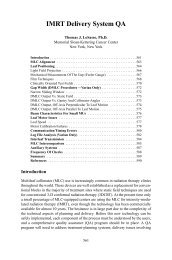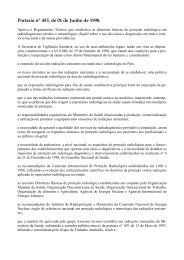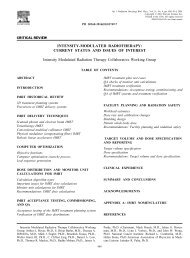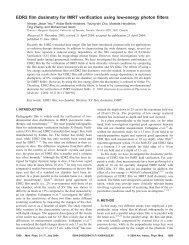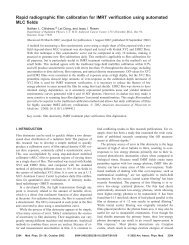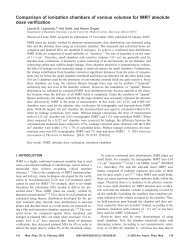Intensity-modulated radiotherapy by means of static tomotherapy: A ...
Intensity-modulated radiotherapy by means of static tomotherapy: A ...
Intensity-modulated radiotherapy by means of static tomotherapy: A ...
You also want an ePaper? Increase the reach of your titles
YUMPU automatically turns print PDFs into web optimized ePapers that Google loves.
<strong>Intensity</strong>-<strong>modulated</strong> <strong>radiotherapy</strong> <strong>by</strong> <strong>means</strong> <strong>of</strong> <strong>static</strong> <strong>tomotherapy</strong>:<br />
A planning and verification study<br />
Mark Oldham and Steve Webb<br />
Joint Department <strong>of</strong> Physics, Institute <strong>of</strong> Cancer Research and the Royal Marsden NHS Trust,<br />
Downs Road, Sutton, Surrey, SM2 5PT, United Kingdom<br />
Received 25 July 1996; accepted for publication 15 March 1997<br />
There is currently much research interest in developing, evaluating, and verifying intensitymodulation<br />
techniques. Of particular interest is how well the delivery <strong>of</strong> intensity-<strong>modulated</strong> pr<strong>of</strong>iles<br />
can be simulated <strong>by</strong> planning algorithms, and how accurately these pr<strong>of</strong>iles can be delivered<br />
given the specification constraints <strong>of</strong> linear accelerators. In this paper we present a planning and<br />
verification study based on delivering radiation in ‘‘<strong>static</strong>-<strong>tomotherapy</strong>’’ mode via the NOMOS<br />
MIMiC Multileaf intensity-modulation collimator, which sheds some light on these issues. An<br />
inverse-planning algorithm was used to compute intensity-<strong>modulated</strong> pr<strong>of</strong>iles for a 9-coplanar-field<br />
plan for a body phantom. The algorithm makes several approximations about the form <strong>of</strong> the<br />
elementary fluence pr<strong>of</strong>ile through bixels during delivery. Specifically, it is independent <strong>of</strong> the state<br />
<strong>of</strong> adjacent bixels i.e., open or closed and obeys the superposition principle. From the standpoint<br />
<strong>of</strong> comparing the predicted versus the delivered dose, these assumptions were made irrelevant <strong>by</strong> a<br />
final one-step forward dose calculation performed using the optimized intensity pr<strong>of</strong>iles. This forward<br />
dose calculation took into account the penumbral characteristics <strong>of</strong> the delivery system <strong>by</strong><br />
decomposing the intensity pr<strong>of</strong>iles into the set <strong>of</strong> delivery components. Each component was assigned<br />
the appropriate penumbral functions there<strong>by</strong> ensuring that the calculated dose distribution<br />
closely predicted the delivered dose distribution. The nine intensity <strong>modulated</strong> fields were delivered<br />
to a perspex phantom with the same geometry, containing a verification film. In general good<br />
agreement was found between the predicted and the measured delivered dose distributions. All the<br />
main features <strong>of</strong> the predicted dose distribution are seen in the delivered. The 90% isodoses were<br />
consistently in spatial agreement to within 3 mm. At the 50% isodose level consistent spatial<br />
agreement was again found to within 3 mm, the largest deviation being about 5 mm. The close<br />
correspondence between the predicted and measured dose distribution demonstrates the potential <strong>of</strong><br />
the MIMiC delivery system. Our results indicate the level <strong>of</strong> dose conformation that is achievable<br />
in practice and the accuracy <strong>of</strong> the dose computation algorithm. However, this study only concerned<br />
delivery <strong>of</strong> radiation to a2cmthick slice, and the dose distribution was only verified in the central<br />
plane <strong>of</strong> the phantom where the film was placed. We therefore cannot comment as yet on what<br />
happens to the dose distribution away from the central film-plane. © 1997 American Association<br />
<strong>of</strong> Physicists in Medicine. S0094-24059700506-3<br />
Key words: intensity modulation, <strong>radiotherapy</strong>, conformal therapy, verification, <strong>tomotherapy</strong>, film<br />
dosimetry<br />
I. INTRODUCTION<br />
New techniques to modulate the intensity <strong>of</strong> radiation in<br />
external-beam <strong>radiotherapy</strong> enable much more precise tailoring<br />
<strong>of</strong> the spatial distribution <strong>of</strong> the delivered high-dose region<br />
to the shape <strong>of</strong> the tumor than can be obtained with<br />
conventional therapy. Many physical methods have been<br />
proposed that could achieve this modulation. The methods<br />
differ in their complexity and in the hardware necessary to<br />
deliver the radiation. All <strong>of</strong> these methods can be classified<br />
into one <strong>of</strong> three groups, each group having as the common<br />
denominator a type <strong>of</strong> hardware used to modulate the intensity<br />
<strong>of</strong> radiation. These three hardware groups are a<br />
multileaf-collimators, b <strong>tomotherapy</strong>-type slit collimators,<br />
and c moving-bar collimators. In group a the intensity <strong>of</strong><br />
geometrically shaped radiation fields is <strong>modulated</strong> either <strong>by</strong><br />
dynamically moving the leaves <strong>of</strong> the MLC during irradiation,<br />
or <strong>by</strong> multiple-<strong>static</strong> segmented irradiation. In group<br />
b, a slit <strong>of</strong> radiation is rotated transaxially about the patient<br />
with the long axis <strong>of</strong> the slit aligned transaxially. The radiation<br />
along the slit is <strong>modulated</strong> <strong>by</strong> short vanes that move into<br />
and out <strong>of</strong> the slit. This modulation can take place either with<br />
continuous gantry rotation or with the gantry at a series <strong>of</strong><br />
fixed orientations. The latter we call <strong>static</strong>-<strong>tomotherapy</strong>. In<br />
group c a small bar is moved across the field with varying<br />
velocity during irradiation. All <strong>of</strong> these techniques aim to<br />
improve on the use <strong>of</strong> compensators, the traditional way to<br />
obtain intensity-<strong>modulated</strong> beams IMBs. 1<br />
There is currently much interest in developing, evaluating,<br />
and verifying all <strong>of</strong> the intensity-modulation techniques.<br />
Several questions are <strong>of</strong> particular significance. These include:<br />
1 How much <strong>of</strong> an improvement can intensity modulation<br />
make to <strong>radiotherapy</strong> dose distributions? 2 What<br />
827 Med. Phys. 24 (6), June 1997 0094-2405/97/24(6)/827/10/$10.00 © 1997 Am. Assoc. Phys. Med. 827
828 M. Oldham and S. Webb: <strong>Intensity</strong>-<strong>modulated</strong> <strong>radiotherapy</strong> 828<br />
FIG. 2. The planning problem studied in this paper dimensions given in the<br />
text. The PTV is the ‘‘bean-shaped’’ invaginated region resulting from the<br />
removal <strong>of</strong> parts <strong>of</strong> two circles the OARs from an ellipse. The problem<br />
represents a prostate PTV with bladder and rectum OARs. The ‘‘I values’’<br />
are the importance-factors used in the inverse planning.<br />
FIG. 1. A schematic illustration <strong>of</strong> the slit beam <strong>of</strong> the MIMiC and its bixels<br />
in relation to the patient. Open bixels are shown as white spaces and closed<br />
bixels as black spaces. The vanes <strong>of</strong> the MIMiC are not shown, but five <strong>of</strong><br />
the actuating mechanisms which can open or close the vanes are shown<br />
schematically.<br />
level <strong>of</strong> intensity modulation is optimal? 3 Where does the<br />
trade-<strong>of</strong>f start to become unfavorable between increasingly<br />
complex and expensive treatments and improved dose distributions?<br />
And 4 which tumor types and disease sites will<br />
the new techniques be most useful for? Two <strong>of</strong> the most<br />
central questions are how well can the intensity-<strong>modulated</strong><br />
dose delivery be simulated with current planning algorithms,<br />
and how accurately can an intensity-<strong>modulated</strong> plan be delivered<br />
in practice given the specification constraints <strong>of</strong> linear<br />
accelerators? In this paper we present a planning and<br />
verification study, in the <strong>static</strong>-<strong>tomotherapy</strong> framework,<br />
which sheds some light on the latter two issues. Investigating<br />
the dosimetry <strong>of</strong> the MIMiC in <strong>static</strong> <strong>tomotherapy</strong> mode is<br />
easier than for rotational <strong>tomotherapy</strong> due to the lack <strong>of</strong><br />
smearing <strong>of</strong> the dose distribution and issues <strong>of</strong> the stability<br />
<strong>of</strong> MU delivery per degree. This study is therefore a necessary<br />
first step in investigating the dosimetry <strong>of</strong> the MIMiC.<br />
II. METHOD<br />
In this paper we present a planning and verification study<br />
based on delivering radiation in ‘‘<strong>static</strong>-<strong>tomotherapy</strong>’’ mode<br />
via the NOMOS 2591 Wexford Bayne Road, Suite 315,<br />
Sewickley, PA, 15143 MIMiC 2–7 Multileaf <strong>Intensity</strong>-<br />
Modulation Collimator Fig. 1. The MIMiC device attaches<br />
to the blocking tray <strong>of</strong> the linear accelerator and positional<br />
adjustment screws and bolts enable the collimation slit to be<br />
accurately aligned with the cross wires. The center <strong>of</strong> the<br />
cross wires coincides with the center <strong>of</strong> the slit, the edges <strong>of</strong><br />
which are made parallel with the respective cross wire. The<br />
intensity along the slit beam <strong>of</strong> the MIMiC can be <strong>modulated</strong><br />
<strong>by</strong> small absorbing vanes illustrated in Fig. 1 that move in<br />
and out <strong>of</strong> the slit under computer control. The vanes are<br />
arranged in two parallel banks, one superiorly and one inferiorly<br />
to the slit. The MIMiC can be used in either rotational<br />
mode, where the vanes move as the gantry rotates, or <strong>static</strong><br />
mode, where the vanes move but the gantry is fixed at some<br />
orientation. The former is conventionally termed <strong>tomotherapy</strong><br />
and the latter we refer to as <strong>static</strong> <strong>tomotherapy</strong>.<br />
The planning problem addressed is an idealized model <strong>of</strong><br />
the treatment <strong>of</strong> an invaginated prostate patient illustrated in<br />
Fig. 2. The patient contor was assumed elliptical with major<br />
and minor axes <strong>of</strong> lengths 29 and 25 cm, respectively. The<br />
planning-target-volume PTV was part <strong>of</strong> an ellipse, major<br />
and minor axes <strong>of</strong> 9 and 7 cm, the center <strong>of</strong> which was<br />
<strong>of</strong>fset vertically below the center <strong>of</strong> the contour <strong>by</strong> 2 cm.<br />
Two circular organs-at-risk OAR were located above and<br />
below the PTV with radii 4 and 1.5 cm, respectively. The<br />
centers <strong>of</strong> the OARs were positioned 5 cm above and 4 cm<br />
below the center <strong>of</strong> the PTV, the latter being defined as the<br />
isocenter. The PTV was the invaginated region created <strong>by</strong><br />
the subtraction <strong>of</strong> parts <strong>of</strong> the circular OARs from the ellipse.<br />
A circular radius 7.25 cm region <strong>of</strong> sensitive tissue was<br />
defined enclosing the PTV and both OARs as shown. The<br />
axial thickness <strong>of</strong> the phantom was specified as extending for<br />
12 transaxial slices each <strong>of</strong> thickness 1 mm, with no change<br />
in the contours <strong>of</strong> any <strong>of</strong> the structures.<br />
Fitting the high-dose region to such an invaginated PTV,<br />
with directly abutting OARs constitutes a very difficult planning<br />
problem, and one that would not be achievable with<br />
conventional <strong>radiotherapy</strong> techniques. 8<br />
A. Inverse planning and forward dose calculation <strong>by</strong><br />
components<br />
A relative dose prescription <strong>of</strong> 1.0 in the PTV, 0.1 in the<br />
two small OARs and 0.3 in the circumscribing sensitive tissue,<br />
was specified in the planning problem <strong>of</strong> Fig. 2 see<br />
Appendix B for a discussion <strong>of</strong> these units. Then a plan<br />
consisting <strong>of</strong> nine equi-spaced co-planar fixed slit fields was<br />
designed, with gantry angles <strong>of</strong> 0°, 40°, 80°, 120°, 160°,<br />
200°, 240°, 280°, and 320°. A set <strong>of</strong> intensity-<strong>modulated</strong><br />
beams was computed <strong>by</strong> solving the inverse problem <strong>by</strong><br />
least-squares iteration. 9 The planning s<strong>of</strong>tware was written<br />
in-house to exactly simulate the geometry <strong>of</strong> the MIMiC, and<br />
Medical Physics, Vol. 24, No. 6, June 1997
829 M. Oldham and S. Webb: <strong>Intensity</strong>-<strong>modulated</strong> <strong>radiotherapy</strong> 829<br />
the inverse algorithm assumed an elemental fluence pr<strong>of</strong>ile<br />
for each bixel which incorporated the penumbral effects <strong>of</strong><br />
the surrounding closed vanes. Bixel is the term used to refer<br />
to the cross-sectional area <strong>of</strong> a vane <strong>of</strong> the MIMiC through<br />
which radiation can pass if the vane is open. The planning<br />
algorithm is essentially similar to that used in the PEACOCK<br />
planning system. It was written to provide the potential to<br />
independently study effects such as bixel pr<strong>of</strong>ile variation,<br />
inhomogeneity, and gantry sag. In this study the elemental<br />
fluence pr<strong>of</strong>ile was found <strong>by</strong> fitting the measured dose data,<br />
delivered <strong>by</strong> a single open vane at 10 cm depth in water, to a<br />
mathematical function which obeys the superposition principle.<br />
This function is a convolution <strong>of</strong> a double exponential<br />
with a rect function equal to the bixel size. 10,11 The resulting<br />
pr<strong>of</strong>ile, which we call the ‘‘stretched-fit’’ pr<strong>of</strong>ile, has the<br />
property that when the fluence pr<strong>of</strong>iles <strong>of</strong> adjacent open bixels<br />
are combined corresponding to two bixels being open at<br />
the same time the resulting fluence pr<strong>of</strong>ile is flat across the<br />
two bixels as it must be in reality. The terminology stretched<br />
fit signifies that the fitting procedure actually widens the elementary<br />
fluence pr<strong>of</strong>ile since superposition <strong>of</strong> the measured<br />
pr<strong>of</strong>iles leads to regions <strong>of</strong> low fluence between bixels. This<br />
fitting procedure is discussed in detail in an earlier report. 11<br />
The dose computation grid was set at 1 mm resolution, with<br />
dimensions<strong>of</strong>300 300 12.<br />
Once the intensity-<strong>modulated</strong> pr<strong>of</strong>iles were determined<br />
for the nine <strong>static</strong> ports, a forward dose calculation was performed<br />
to predict the delivered dose taking into account the<br />
characteristics <strong>of</strong> the delivery method. This is a crucial point<br />
we wish to elaborate on. The key point is that during planning<br />
the elemental fluence pr<strong>of</strong>ile used for each bixel assumes<br />
that the neighboring bixels are closed. This is necessary<br />
as a priori information <strong>of</strong> the intensity-<strong>modulated</strong><br />
pr<strong>of</strong>ile is not available. When it comes to the delivery <strong>of</strong> the<br />
fluence through a bixel however, the neighboring bixels may<br />
well be either open, closed, or open for part <strong>of</strong> the irradiation.<br />
In essence, the penumbral effects assumed at the planning<br />
stage do not reflect what happens during the delivery.<br />
To circumvent this discrepancy, the first step <strong>of</strong> the forward<br />
dose calculation is the decomposition <strong>of</strong> the intensity<strong>modulated</strong><br />
pr<strong>of</strong>iles into their respective components. 11 Each<br />
component is a combination <strong>of</strong> open and closed vanes<br />
through which an amount <strong>of</strong> radiation is delivered. The delivery<br />
<strong>of</strong> any intensity-<strong>modulated</strong> pr<strong>of</strong>ile must, in practice,<br />
adopt this decomposition concept. The alternative is to deliver<br />
each bixel independently, with all other bixels closed,<br />
which would be far too time consuming and give too high a<br />
leakage dose. As with the planning s<strong>of</strong>tware, this forward<br />
dose calculation was written in-house to allow independent<br />
study <strong>of</strong> effects such as the penumbral characteristics during<br />
delivery. The NOMOS planning system PEACOCK does not<br />
use our component delivery method to model the penumbral<br />
effects during delivery.<br />
The forward dose calculation used in this study first computed<br />
the component bixel patterns for each gantry angle<br />
Appendix A. Then the appropriate fluence pr<strong>of</strong>iles were<br />
assigned to each component. Between adjacent open bixels<br />
the stretched-fit pr<strong>of</strong>ile was assigned ensuring a flat pr<strong>of</strong>ile.<br />
FIG. 3. The variation in relative-output-factor ROF between different bixels<br />
along the MIMiC for the PHILIPS SL 75/5. ROF’s are given in percentages,<br />
defined with respect to a 10 10 cm 2 open field measured at the dose<br />
maximum.<br />
Between an open and closed bixel, the appropriate measured<br />
penumbral pr<strong>of</strong>ile was assumed. By accurately modeling<br />
how the MIMiC delivers an intensity-<strong>modulated</strong> pr<strong>of</strong>ile via<br />
components, this forward dose calculation takes account <strong>of</strong><br />
the penumbral characteristics <strong>of</strong> the delivery system. Furthermore,<br />
the variation in relative-output-factor ROF for<br />
bixels at different positions in the slit was incorporated <strong>by</strong><br />
assigning each bixel a unique ROF obtained from fitting all<br />
bixels to the measured data for the open slit field Fig. 3. It<br />
is noted that only the centrally positioned bixels numbers<br />
6–15 have a significant amount <strong>of</strong> radiation passing through<br />
them in this study. An example <strong>of</strong> an intensity-<strong>modulated</strong><br />
pr<strong>of</strong>ile and its corresponding delivery components are given<br />
in Fig. 4 and Table I. Note that this is only one <strong>of</strong> many<br />
possible decomposition patterns. 12 However, as the MIMiC<br />
was operated <strong>by</strong> initially opening as many leaves as possible<br />
FIG. 4. The intensity-<strong>modulated</strong> pr<strong>of</strong>ile found <strong>by</strong> inverse-planning for the<br />
field at gantry angle 0°.<br />
Medical Physics, Vol. 24, No. 6, June 1997
830 M. Oldham and S. Webb: <strong>Intensity</strong>-<strong>modulated</strong> <strong>radiotherapy</strong> 830<br />
TABLE I. This table illustrates the decomposed components, and the number<br />
<strong>of</strong> monitor units delivered to each component, <strong>of</strong> the intensity-<strong>modulated</strong><br />
pr<strong>of</strong>ile <strong>of</strong> Fig. 4.<br />
Component Open bixels Monitor units<br />
1 6–8, 12–15 1<br />
2 6–8, 13–15 6<br />
3 6–7, 14–15 6<br />
4 6–7, 14 1<br />
for a pr<strong>of</strong>ile and gradually shutting them as required, this is<br />
the actual decomposition pattern delivered <strong>by</strong> the MIMiC.<br />
The intensity pr<strong>of</strong>iles found <strong>by</strong> inverse planning for all nine<br />
gantry angles are shown in Fig. 5. The forward dose calculation<br />
was performed with the IMB pr<strong>of</strong>iles discretized to the<br />
nearest integer MU since fractions <strong>of</strong> a MU cannot be delivered<br />
in practice. The absolute values were chosen to give<br />
0.82 Gy to the maximum dose point Appendix B.<br />
B. Delivery and film measurement<br />
The intensity pr<strong>of</strong>iles <strong>of</strong> the nine fields Fig. 5 were delivered<br />
to a perspex phantom with the geometry given in Fig.<br />
2. The perspex phantom was constructed in two parts, each<br />
part having the dimensions <strong>of</strong> Fig. 2 with a thickness <strong>of</strong> 2<br />
cm. These two parts were then placed back-to-back on the<br />
treatment couch sandwiching a piece <strong>of</strong> Kodak X-OMAT V<br />
standard verification film between them. For each component<br />
<strong>of</strong> each field, the vane configuration was set manually via<br />
interaction with the touch-screen computer that is attached to<br />
the MIMiC. The same IMB was fed into each bank at any<br />
one orientation, and the MIMiC was attached to a PHILIPS<br />
SL 75/5 accelerator. The appropriate number <strong>of</strong> monitor<br />
units <strong>of</strong> dose was then delivered through that component’s<br />
vane configuration. This procedure necessitated that an operator<br />
entered the treatment room to set the MIMiC for each<br />
configuration. In all there were 62 component-vane configurations<br />
set making the total treatment time completely unfeasible<br />
for clinical routine about 2 h but acceptable for a<br />
one-<strong>of</strong>f experimental demonstration <strong>of</strong> principle. The manual<br />
FIG. 5. The intensity pr<strong>of</strong>iles found <strong>by</strong> inverse-planning for the MIMiC fields at gantry angles 0°, 40°, 80°, 120°, 160°, 200°, 240°, 280°, and 320°. The<br />
pr<strong>of</strong>iles were discretized to the nearest MU.<br />
Medical Physics, Vol. 24, No. 6, June 1997
831 M. Oldham and S. Webb: <strong>Intensity</strong>-<strong>modulated</strong> <strong>radiotherapy</strong> 831<br />
setting <strong>of</strong> vane configurations was necessary as the control<br />
s<strong>of</strong>tware to automatically deliver components in this way is<br />
not yet available. The functionality to automatically deliver<br />
a sequence <strong>of</strong> component vane configurations, without the<br />
need for an operator to enter the treatment room, does exist if<br />
the intensity-<strong>modulated</strong> pr<strong>of</strong>ile to be delivered has been produced<br />
<strong>by</strong> the PEACOCK planning s<strong>of</strong>tware. 6,13 <br />
At delivery the perspex phantom was positioned vertically<br />
on the couch so that the flat plane <strong>of</strong> the phantom was in the<br />
plane <strong>of</strong> gantry rotation. The couch was then adjusted so that<br />
the plane <strong>of</strong> the verification film sandwiched between the<br />
two halves <strong>of</strong> the phantom coincided with the AB cross wire.<br />
The film was thus positioned in the same plane as the source,<br />
and in the middle <strong>of</strong> the slit <strong>of</strong> radiation defined <strong>by</strong> the two<br />
banks <strong>of</strong> the MIMiC. During delivery, both banks <strong>of</strong> bixels<br />
were treated identically, so that, in effect, the nine intensity<strong>modulated</strong><br />
fields were delivered to a2cmtransaxial slice <strong>of</strong><br />
the phantom. The verification film was located centrally in<br />
this 2 cm slice.<br />
The complex nature <strong>of</strong> the above nine field irradiation<br />
made an accurate comparison <strong>of</strong> the absolute predicted and<br />
measured dosimetry difficult. A second irradiation experiment<br />
was therefore performed to verify the absolute dosimetry<br />
<strong>of</strong> the forward dose calculation for the case <strong>of</strong> a single<br />
intensity <strong>modulated</strong> field: That at gantry angle zero Fig. 4<br />
and Table I. In this simpler problem the confusing effects <strong>of</strong><br />
dose smearing from multiple-fields, gantry sag, flatness, and<br />
output variation with gantry angle etc., are reduced. The<br />
number <strong>of</strong> monitor units in Table I were increased <strong>by</strong> a factor<br />
<strong>of</strong> 3 for this irradiation to give an appropriate dose to the<br />
film in the absence <strong>of</strong> the other eight beams. A new high<br />
performance verification film was used which is reported 14 to<br />
be highly linear between 0–0.5 Gy, to have negligible energy<br />
response, and to have a 2% inter and intrafilm consistency.<br />
A further advantage <strong>of</strong> this film is that it is available in<br />
vacuum-sealed water-pro<strong>of</strong> packaging removing problems<br />
associated with air spaces trapped in the film packaging and<br />
enabling depth-dose measurements in water. Our measurements<br />
confirm the superior performance <strong>of</strong> this film calibration<br />
curve is shown in Fig. 6a, and a comparison <strong>of</strong> the<br />
depth-dose curve in water measured <strong>by</strong> film and ion chamber<br />
in Fig. 6b, however we observed saturation at the much<br />
lower dose value <strong>of</strong> about 0.6 Gy compared to the reported<br />
0.9 Gy. 14 Both the CEA and Kodak film sensitivity were<br />
greater when the film was oriented perpendicular to the incoming<br />
radiation Fig. 6a. In both experiments the film<br />
was actually oriented parallel to the incoming radiation and<br />
so the parallel orientation calibration curves were used to<br />
convert from optical density to dose. It is clear from Fig. 6b<br />
that the sensitivity <strong>of</strong> both types <strong>of</strong> film remains independent<br />
<strong>of</strong> any spectral hardening with depth. It was not feasible to<br />
use the CEA film for the nine field irradiation experiment<br />
because its low-dose saturation property would necessitate<br />
delivering less MU for each field and much <strong>of</strong> the fine detail<br />
would have been lost.<br />
FIG. 6. a Calibration curves for the CEA dotted lines and Kodak<br />
X-OMAT V solid lines film. The two calibration curves for each film<br />
correspond to whether the film is perpendicular or parallel to incoming<br />
radiation. Radiation sensitivity is higher for perpendicularly oriented film in<br />
both cases. b Comparison <strong>of</strong> depth-dose measurements in water taken with<br />
CEA film triangles, Kodak X-OMAT V film stars and an ion chamber<br />
squares. The data were normalized at 5 cm depth. The close agreement<br />
indicates the negligible energy response <strong>of</strong> both the CEA and Kodak film.<br />
III. RESULTS<br />
The measured and predicted absolute isodose lines for the<br />
single field irradiation are shown in Fig. 7. Predicted isodoses<br />
were found <strong>by</strong> interpolation from dose points on a 2<br />
mm grid spacing. Note—As the distribution was only computed<br />
for the region inside the circular outer OAR <strong>of</strong> Fig. 2,<br />
the predicted isodoses do not extend to the full extent <strong>of</strong> the<br />
measured. Excellent agreement is observed between the film<br />
and the forward dose calculation prediction, although the effect<br />
<strong>of</strong> the increased spatial resolution <strong>of</strong> the film is visible in<br />
the regions <strong>of</strong> high dose gradient at the edges. The close<br />
agreement between measurement and prediction indicates<br />
that the component delivery CD forward dose calculation<br />
model is accurate to within a few percent. Use <strong>of</strong> the new<br />
high performance CEA film enabled a more accurate measurement<br />
than would have been possible with conventional<br />
verification film.<br />
Medical Physics, Vol. 24, No. 6, June 1997
832 M. Oldham and S. Webb: <strong>Intensity</strong>-<strong>modulated</strong> <strong>radiotherapy</strong> 832<br />
FIG. 7. Comparison <strong>of</strong> predicted dotted lines with measured solid lines<br />
absolute isodose lines cGy for the single intensity <strong>modulated</strong> field irradiation.<br />
The predicted dose distribution corresponding to the nine<br />
intensity-<strong>modulated</strong> fields as found <strong>by</strong> the forward dose calculation<br />
step outlined in Sec. II A is shown in Fig. 8a.<br />
Isodoses, interpolated from dose points on a2mmgrid spacing,<br />
are shown after the distribution has been normalized to<br />
the maximum dose in the plane. As the distribution was only<br />
computed for the region inside the circular outer OAR <strong>of</strong><br />
Fig. 2, the very low isodoses follow this OAR at the edges.<br />
In reality the isodoses will not assume this circularity at the<br />
edge. At delivery, Fig. 5 shows that a total <strong>of</strong> almost 200<br />
monitor units were delivered to the perspex phantom via the<br />
62 component vane configurations. This arrangement led to a<br />
maximum dose in the PTV as predicted <strong>by</strong> the planning s<strong>of</strong>tware<br />
<strong>of</strong> 0.82 Gy Appendix B. On completion <strong>of</strong> the delivery,<br />
the film was developed and the delivered dose distribution<br />
was scanned Fig. 8b via an optical densitometer<br />
Wellhöffer WP102. The scan performed was a 2D net scan<br />
with each line <strong>of</strong> the scan containing 16 values per mm along<br />
its length, and with line spacing <strong>of</strong> 0.5 cm. The 2D netscan<br />
lines were performed in both the x and y directions. Conversion<br />
from optical density values to dose values was achieved<br />
using a calibration curve obtained from irradiations <strong>of</strong> other<br />
verification films in the same pack.<br />
The predicted and measured dose distributions Figs. 8a<br />
and 8b were compared <strong>by</strong> photocopying the predicted distribution<br />
onto an OHP transparency so that it could be overlaid<br />
on top <strong>of</strong> the measured distribution. The general agreement<br />
between the two dose distributions is very good. The<br />
90% isodose line <strong>of</strong> the delivered distribution clearly shows<br />
two concavities where the OARs are adjacent to the PTV.<br />
FIG. 8. Isodoses <strong>of</strong> the computer-calculated and film-measured dose distributions.<br />
Isodose lines on both plots are starting from outter lines and moving<br />
inwards 30%, 40%, 50%, 60%, 70%, 75%, 80%, 85%, 90%, 95%,<br />
100% <strong>of</strong> the maximum dose. A scale-drawing <strong>of</strong> the PTV and OAR’s has<br />
been superimposed onto the isodose lines. a The predicted dose distribution<br />
as found <strong>by</strong> the forward dose calculation which takes into account the<br />
penumbral characteristics <strong>of</strong> the delivery technique. b The delivered dose<br />
distribution as measured <strong>by</strong> verification film.<br />
Lower isodose lines also clearly show that the dose in the<br />
OARs has been kept relatively very low compared to the<br />
dose in the PTV. All the main features <strong>of</strong> the predicted dose<br />
distribution are seen in the delivered except for the artificial<br />
circularity <strong>of</strong> low-dose isodoses at the edges. The 90% isodoses<br />
are consistently in spatial agreement to within 3 mm<br />
except for in the lower right hand region where the predicted<br />
isodose makes a small kink into the body <strong>of</strong> the PTV. At the<br />
50% isodose level consistent spatial agreement is again<br />
found to within 3 mm, the largest deviation being about 5<br />
mm. Although the general shape <strong>of</strong> the distributions agree<br />
well, the delivered distribution is asymmetrically hotter on<br />
Medical Physics, Vol. 24, No. 6, June 1997
833 M. Oldham and S. Webb: <strong>Intensity</strong>-<strong>modulated</strong> <strong>radiotherapy</strong> 833<br />
FIG. 9. Plot <strong>of</strong> the relative dose-per-MU arbitrary units against the number<br />
<strong>of</strong> MU delivered for Gantry settings <strong>of</strong> 0° and 90°.<br />
the left hand side. The reason for this asymmetry is probably<br />
due to any combination <strong>of</strong> a small air spaces in the film, b<br />
misalignment <strong>of</strong> the film in the narrow 2 cm treatment plane,<br />
c gantry sag, d the asymmetric interference <strong>of</strong> a metal<br />
tubular bar on the underside <strong>of</strong> the couch that will have<br />
slightly attenuated the two most posterior fields, and e nonlinearity<br />
<strong>of</strong> dose per MU for small MU see below.<br />
Due to the limitations <strong>of</strong> using film to measure absolute<br />
dosimetry, this study was primarily concerned with investigating<br />
the relative dosimetric agreement between the planned<br />
and delivered distributions. Errors in excess <strong>of</strong> 10% in the<br />
absolute measurement may be introduced <strong>by</strong> any <strong>of</strong> (a – e)<br />
above together with uncertainty in the film calibration.<br />
Against this background <strong>of</strong> uncertainty we measured a maximum<br />
dose on the film <strong>of</strong> (0.97 0.08) Gy compared to the<br />
predicted (0.85 0.04) Gy the uncertainty quoted here is<br />
that <strong>of</strong> the measurement <strong>of</strong> the ROF for a single bixel—see<br />
Eq. A9. One reason for this underestimate in the predicted<br />
dose can be traced to the nonlinearity <strong>of</strong> dose per MU for<br />
small MU deliveries Fig. 9. Figure 9 shows that in the MU<br />
region <strong>of</strong> the majority <strong>of</strong> the component deliveries in the<br />
plan out <strong>of</strong> 62 components, 49 were 6 MU and 38 were<br />
3MUthe dose per MU was 4%–7% higher than that used<br />
in the dose calculation algorithm.<br />
IV. DISCUSSION AND CONCLUSIONS<br />
The first part <strong>of</strong> this study was a s<strong>of</strong>tware simulation <strong>of</strong> an<br />
intensity-<strong>modulated</strong> <strong>radiotherapy</strong> treatment. An inverse optimization<br />
algorithm was used to compute intensity-<strong>modulated</strong><br />
pr<strong>of</strong>iles for the nine fields <strong>of</strong> the plan. This algorithm makes<br />
several unrealistic assumptions about the form <strong>of</strong> the elementary<br />
fluence pr<strong>of</strong>ile through bixels during delivery.<br />
From the standpoint <strong>of</strong> comparing the predicted versus the<br />
delivered dose, however, these assumptions were made irrelevant<br />
<strong>by</strong> the final one-step forward dose calculation performed<br />
using the optimized intensity-<strong>modulated</strong> pr<strong>of</strong>iles.<br />
This forward dose calculation step took into account the penumbral<br />
characteristics <strong>of</strong> the MIMiC delivery system, attached<br />
to a PHILIPS SL75/5 accelerator, <strong>by</strong> decomposing<br />
the intensity pr<strong>of</strong>iles into the delivery components. Each<br />
component was assigned the appropriate penumbral functions<br />
there<strong>by</strong> ensuring that the calculated dose distribution<br />
should predict as closely as possible the delivered distribution.<br />
The second part <strong>of</strong> the study concerned the delivery <strong>of</strong><br />
the intensity-<strong>modulated</strong> plan, its measurement, and the comparison<br />
<strong>of</strong> the delivered dose with the predicted. Both the<br />
inverse planning and the forward dose calculation delivery<br />
model includes ‘‘out-<strong>of</strong>-line-<strong>of</strong>-sight’’ scatter and therefore<br />
our study does not suffer from the problems highlighted <strong>by</strong><br />
Mohan et al. 15<br />
The major uncertainties in the simulation are: a How<br />
well the inverse-planning optimization algorithm performed<br />
i.e., how optimal are the intensity-<strong>modulated</strong> pr<strong>of</strong>iles predicted<br />
for the nine fields, and b how well the forward dose<br />
calculation has modeled the actual delivered dose. In this<br />
paper we are not concerned so much with a as we take as<br />
our starting assumption that the optimized intensity<strong>modulated</strong><br />
pr<strong>of</strong>iles found <strong>by</strong> the inverse-planning algorithm<br />
are near optimal. Note we use ‘‘optimal’’ here to mean that<br />
set <strong>of</strong> intensity pr<strong>of</strong>iles that produce a dose distribution that<br />
most closely matches the prescription. This assumption is<br />
not entirely valid because the stretched-fit elementary fluence<br />
pr<strong>of</strong>ile assumed at the planning stage is a fit <strong>of</strong> the measured<br />
pr<strong>of</strong>ile to a function obeying the superposition principle. This<br />
<strong>means</strong> that although the fluence pr<strong>of</strong>ile across adjacent open<br />
bixels <strong>of</strong> the same intensity is accurately modeled, for adjacent<br />
bixels with nonidentical intensities the penumbral effects<br />
are only approximated. Intuitively one would expect<br />
this effect to be small, a conclusion which is supported <strong>by</strong><br />
the fact that the planned dose distribution Fig. 8a appears<br />
so good in terms <strong>of</strong> homogeneity <strong>of</strong> dose to the PTV while<br />
sparing the OARs.<br />
Uncertainties and omissions in the forward dose calculation<br />
compared with the real delivery situation are i mechanical<br />
factors such as gantry and collimator sag, ii the<br />
uncertainty on the ROF parameter for a single 1 cm 2 bixel<br />
Eq. A9, iii the nonlinearity <strong>of</strong> dose per monitor unit for<br />
small monitor unit doses, and iv errors in positional setup<br />
<strong>of</strong> the phantom. At this stage we are not able to comment<br />
further on the implications or magnitudes <strong>of</strong> these effects. In<br />
future work we intend to expand the planning s<strong>of</strong>tware so<br />
that it can investigate and predict their magnitude.<br />
This paper is more concerned with b above i.e., establishing<br />
how well the forward dose calculation has modeled<br />
the actual delivered dose. We are also interested in investigating<br />
the feasibility <strong>of</strong> the delivery method, and establishing<br />
the level <strong>of</strong> dose conformation achievable with the MIMiC in<br />
<strong>static</strong> <strong>tomotherapy</strong>. The close agreement between the predicted<br />
and measured absolute isodose lines in the single field<br />
experiment <strong>of</strong> Fig. 7 indicate the high accuracy <strong>of</strong> our CD<br />
mode forward dose calculation. 11 The close correspondence<br />
between the predicted and measured dose distribution,<br />
shown in Figs. 8a and 8b, demonstrate the potential <strong>of</strong> the<br />
MIMiC delivery system. These figures indicate the level <strong>of</strong><br />
dose conformation that is achievable in practice and the ac-<br />
Medical Physics, Vol. 24, No. 6, June 1997
834 M. Oldham and S. Webb: <strong>Intensity</strong>-<strong>modulated</strong> <strong>radiotherapy</strong> 834<br />
curacy <strong>of</strong> the dose-computation algorithm. It is pointed out<br />
however, that this study only concerned delivery <strong>of</strong> radiation<br />
toa2cmthick slice, and the dose distribution was only<br />
verified in the central plane where the film was placed. We<br />
therefore cannot comment as yet on what happens to the<br />
dose distribution away from the mid plane. A further important<br />
question-mark hangs over the significance <strong>of</strong> the<br />
matchline problem. The latter concerns the situation where it<br />
is necessary to index the couch in order to treat a PTV that<br />
extends outside <strong>of</strong> the 2 cm delivery slice. To investigate<br />
these areas a full 3D map <strong>of</strong> the delivered dose is required<br />
such as could be obtained <strong>by</strong> gel dosimetry.<br />
ACKNOWLEDGMENTS<br />
We are very grateful to the NOMOS corporation for the<br />
loan <strong>of</strong> a MIMiC and for the help given during installation<br />
and commissioning. In particular to Dr. Mark Carol, Dr.<br />
Alan Bleier, and Dr. Alexis Kania. Dr. James Bedford ICR<br />
gave timely help with the delivery. Thanks also to Dr. Philip<br />
Evans, Dr. Dave Convery, Pr<strong>of</strong>essor W. Swindell, Dr. Alan<br />
Nahum, Mr. Jim Warrington, Mr. Glyn Shentall, Mr. Carl<br />
Rowbottom, and Ms. Vibeke Hansen, <strong>of</strong> ICR/RMNHST for<br />
discussions and pro<strong>of</strong>reading.<br />
APPENDIX A: FORWARD DOSE CALCULATION BY<br />
COMPONENT DELIVERY<br />
The purpose <strong>of</strong> this Appendix is to explain in more detail<br />
the principle <strong>of</strong> dose computation <strong>by</strong> component delivery<br />
CD as introduced <strong>by</strong> Webb and Oldham 1996.<br />
At the inverse-planning stage <strong>of</strong> determining the set <strong>of</strong><br />
IMBs, the delivery <strong>of</strong> radiation through any one bixel is considered<br />
independent <strong>of</strong> the state <strong>of</strong> opening or closing <strong>of</strong><br />
adjoining bixels so-called ‘‘independent-vane IV model’’<br />
since there is no other option. Each ith bixel delivers an<br />
elemental dose distribution j f p<br />
i to the jth dose point D j<br />
weighted <strong>by</strong> its weight w i and the resulting dose distribution<br />
is simply the superposition <strong>of</strong> all independent contributions.<br />
The superscript P distinguishes from the corresponding<br />
quantity at the delivery stage. That is,<br />
N<br />
D j C<br />
i1<br />
jf i P •w i ,<br />
A1<br />
FIG. 10. A beam’s-eye-view illustration <strong>of</strong> the principle <strong>of</strong> component delivery<br />
CD with two banks <strong>of</strong> bixels. Consider the delivery <strong>of</strong> the radiation<br />
through the superior bixel whose intensity is B. This bixel is flanked inferiorly<br />
<strong>by</strong> a bixel whose intensity is B I and flanked in the same bank <strong>by</strong> a<br />
right bixel with intensity B R and a left bixel with intensity B L . When the<br />
four intensities are ranked as shown, the delivery requires the three separate<br />
components shown, each with different components <strong>of</strong> intensity arrowed<br />
and different wall conditions. Note ‘‘right’’ and ‘‘left’’ refer to the beam’seye-view<br />
where converts from dimensionless bixel weight to bixel<br />
MU, and C converts from MU to dose in Gy see Appendix<br />
B.<br />
However, at the treatment delivery stage, while the radiation<br />
through a particular bixel is being delivered, the state <strong>of</strong><br />
opening and closing <strong>of</strong> adjacent bixels will change, since it is<br />
this change which characterizes the intensity modulation.<br />
Consequently the bixel will experience changes in the state<br />
<strong>of</strong> its collimation. For example, if all surrounding bixels are<br />
closed, the bixel has four lead ‘‘walls’’ surrounding it and a<br />
corresponding penumbra. However if one or more adjacent<br />
bixels opens, one or more walls disappears, changing the<br />
state <strong>of</strong> collimation.<br />
To accommodate this a forward dose calculation, subsequent<br />
to inverse planning, was performed in ‘‘componentdelivery<br />
CD mode’’. The delivery through any one bixel i<br />
was broken down into Q i components such that the component<br />
intensities w i,q sum to the total bixel intensity w i , but<br />
the collimation, fixed for each component, changes between<br />
components. Thus the delivered dose distribution becomes<br />
N<br />
D j C<br />
i1<br />
Q i<br />
q1<br />
jf D i,q •w i,q ,<br />
A2<br />
where the quantity j f D<br />
i,q is the dimensionless fractional contribution<br />
from the qth component <strong>of</strong> the ith bixel to the jth<br />
dose point and the superscript D distinguishes this from the<br />
corresponding quantity j f p i at the planning stage. The component<br />
‘‘wall conditions’’ or penumbrae are embodied in<br />
jf D i,q . This principle is illustrated in Fig. 10.<br />
It should be noted that for any particular IMB, quantised<br />
into L discrete intensity levels, there are L! 2 entirely equivalent<br />
possible decompositions <strong>of</strong> the pr<strong>of</strong>ile Yu et al. 1995.<br />
The one illustrated in Table I is just one convenient decomposition.<br />
It is not the same decomposition pattern as the forward<br />
dose calculation in CD mode described above, which<br />
was carried out bixel-<strong>by</strong>-bixel. Provided the accelerator output<br />
is linear with increasing MU, the two are equivalent.<br />
However nonlinearities in accelerator output remove this<br />
Medical Physics, Vol. 24, No. 6, June 1997
835 M. Oldham and S. Webb: <strong>Intensity</strong>-<strong>modulated</strong> <strong>radiotherapy</strong> 835<br />
equivalence and are a possible source <strong>of</strong> comparative error.<br />
The code to make CD calculations is not set up to model this<br />
problem.<br />
APPENDIX B: CALIBRATION AND<br />
DISCRETIZATION OF IMB SETS<br />
Inverse planning creates the bixel intensities or weights<br />
in dimensionless units but with meaningful relative values<br />
such that, when the radiation through the bixels is delivered,<br />
the dimensionless dose distribution created matches the dimensionless<br />
prescription as closely as possible.<br />
The purpose <strong>of</strong> this Appendix is to explain how the bixel<br />
intensities in the IMB sets were determined in units <strong>of</strong> MU.<br />
Let there be N bixels, labeled <strong>by</strong> i with w i the weight <strong>of</strong><br />
the ith bixel determined at the inverse-planning stage and<br />
M i the corresponding value in MU. Let the corresponding<br />
component weights be w i,q and M i,q see Appendix A<br />
where, with the ith bixel delivered in Q i components<br />
w i <br />
q1<br />
M i <br />
q1<br />
Q i<br />
w i,q , B1<br />
Q i<br />
M i,q . B2<br />
Let the dose in Gy at the jth dosepoint be D j and the maximum<br />
dose in the plan be (D j ) max . Let j f D<br />
i,q be the dimensionless<br />
fractional contribution from the qth component <strong>of</strong> the<br />
ith bixel to the jth dosepoint. The superscript D distinguishes<br />
this from the corresponding quantity j f P i at the planning<br />
stage—see Appendix A. Let convert from dimensionless<br />
bixel weight to bixel MU. Let C convert from MU<br />
in beam space to dose in Gy in dose space C was determined<br />
<strong>by</strong> definition and experiment—see later.<br />
Then for the ith bixel, the dose to the jth dose point is<br />
Q i<br />
D j C jf D i,q •M i,q .<br />
B3<br />
q1<br />
The total dose to the jth dose point from all N bixels is<br />
N<br />
D j C<br />
i1<br />
By definition<br />
Q i<br />
q1<br />
M i,q w i,q .<br />
jf D i,q •M i,q .<br />
So, combining Eqs. B4 and B5<br />
N<br />
D j C<br />
i1<br />
Q i<br />
q1<br />
jf D i,q •w i,q .<br />
The maximum dose in the plan is<br />
D j max C<br />
N<br />
i1<br />
<br />
Q i<br />
q1<br />
B4<br />
B5<br />
B6<br />
jf D i,q •w i,q . B7<br />
max<br />
Inverting Eq. B7 gives the conversion factor <br />
N<br />
Q i<br />
D j max /C<br />
i1<br />
q1 jf D i,q •w i,q . B8<br />
max<br />
Radiotherapy machines which deliver simple open fields are<br />
calibrated and setup so that, <strong>by</strong> definition, 100 MUs gives a<br />
dose <strong>of</strong> 1 Gy to the maximum <strong>of</strong> the depth-dose curve for a<br />
field <strong>of</strong> size (10 10) cm 2 where, C 0.01 Gy MU 1 . For<br />
the MIMiC, however, we measured the relative output factor<br />
ROF, determining that, for a single open bixel, 100 MU<br />
delivered a dose <strong>of</strong> 0.822 Gy, where<strong>by</strong>, from Eq. B3 with<br />
Q i 1 and j f D<br />
i,q 1, C 8.22 10 3 Gy MU 1 . In inverse<br />
planning the dose distribution was normalized so<br />
N<br />
<br />
i1<br />
<br />
Q i<br />
q1<br />
jf D i,q •w i,q 1.0.<br />
max<br />
It was decided that, in order to arrange that the dose distribution<br />
fell on the linear part <strong>of</strong> the film response curve<br />
(D j ) max was set to 0.822 Gy in the central plane <strong>of</strong> one leaf<br />
bank, where<strong>by</strong> from Eq. B8, 100.<br />
Thus the weights w i and their components w i,q determined<br />
<strong>by</strong> inverse planning were multiplied <strong>by</strong> 100 Eq. B5<br />
to arrive at the bixel intensities M i and their components<br />
M i,q in MU. The IMB sets were then discretized so each<br />
bixel intensity was at the nearest integer number <strong>of</strong> MUs<br />
since the accelerator can only deliver integer numbers <strong>of</strong><br />
MUs. In passing we may note that, from Eqs. B6 and B7<br />
isodoses in the plan are defined such that the pth isodose,<br />
expressed as a fraction, is<br />
D j<br />
p<br />
D j max<br />
N<br />
<br />
i1<br />
Q i<br />
q1<br />
N<br />
jf D i,q •w i,q <br />
i1<br />
<br />
Q i<br />
q1<br />
jf D i,q •w i,q , B9<br />
max<br />
and an alternative, but equivalent, definition <strong>of</strong> normalizing<br />
to the dose (D j ) max at the isocenter, is<br />
N<br />
D j iso /C <br />
i1<br />
Q i<br />
q1<br />
jf D i,q •w i,q . B10<br />
iso<br />
1 S. Webb, ‘‘The physics <strong>of</strong> three-dimensional radiation therapy: Conformal<br />
<strong>radiotherapy</strong>, radiosurgery and treatment planning’’ Bristol: IOPP<br />
1993.<br />
2 M. P. Carol, ‘‘An automatic 3D treatment planning and implementation<br />
system for optimized conformal therapy <strong>by</strong> the NOMOS Corporation’’<br />
Proc. 34th Annual Meeting <strong>of</strong> the American Society for Therapeutic Radiology<br />
and Oncology. Nov. 1992.<br />
3 M. P. Carol, ‘‘An automatic 3D conformal treatment planning system for<br />
linear accelerator based beam modulation <strong>radiotherapy</strong>’’ in ‘‘The use <strong>of</strong><br />
computers in radiation therapy: Proceedings <strong>of</strong> the 11th Conference,’’<br />
edited <strong>by</strong> A. R. Hounsell et al. Manchester, pp. 108–109 1994.<br />
4 M. P. Carol, ‘‘Integrated 3D conformal multivane intensity modulation<br />
delivery system for <strong>radiotherapy</strong>’’ in ‘‘The use <strong>of</strong> computers in radiation<br />
therapy: Proceedings <strong>of</strong> the 11th Conference’’ edited <strong>by</strong> A. R. Hounsell<br />
et al. Manchester, pp. 172–173 1994.<br />
5 M. P. Carol, ‘‘Peacock: a system for planning and rotational delivery <strong>of</strong><br />
intensity-<strong>modulated</strong> fields,’’ Int. J. <strong>of</strong> Imaging Systems and Technology:<br />
Special Issue on ‘‘Optimization <strong>of</strong> the Three-Dimensional Dose Delivery<br />
and Tomotherapy’’ 6, 56–61 1995.<br />
Medical Physics, Vol. 24, No. 6, June 1997
836 M. Oldham and S. Webb: <strong>Intensity</strong>-<strong>modulated</strong> <strong>radiotherapy</strong> 836<br />
6 M. P. Carol, W. Grant III, A. R. Bleier, A. A. Kania, H. S. Targovnik, E.<br />
B. Butler, and S. W. Woo, ‘‘The field-matching problem as it applies to<br />
the Peacock three-dimensional conformal system for intensity modulation’’<br />
Int. J. Rad. Oncol. Biol. Phys. 34, 183–187 1996.<br />
7 M. P. Carol, H. Targovnik, C. Campbell, A. Bleier, J. Strait, B. Rosen, P.<br />
Miller, D. Scherch, R. Huber, B. Thibadeau, D. Dawson, and D. Ruff,<br />
‘‘An automatic 3D treatment planning and implementation system for<br />
optimized conformal therapy,’’ in ‘‘Three-Dimensional Treatment Planning,’’<br />
edited and published <strong>by</strong> P. Minet Proceedings <strong>of</strong> the EAR Conference<br />
in Geneva at WHO; October 1992, pp. 173–187 1993.<br />
8 S. Webb, ‘‘Optimization <strong>of</strong> conformal <strong>radiotherapy</strong> dose distributions <strong>by</strong><br />
simulated annealing,’’ Phys. Med. Biol. 34, 1349–69 1989.<br />
9 S. Webb, ‘‘Optimizing the planning <strong>of</strong> intensity-<strong>modulated</strong> <strong>radiotherapy</strong>,’’<br />
Phys. Med. Biol. 39, 2229–2246 1994.<br />
10 A. Bleier, Private communication from the NOMOS Corporation 1995.<br />
11 S. Webb, and M. Oldham, ‘‘A method to study the characteristics <strong>of</strong> 3D<br />
dose distributions created <strong>by</strong> superposition <strong>of</strong> many intensity-<strong>modulated</strong><br />
beams delivered via a slit aperture with multiple absorbing vanes,’’ Phys.<br />
Med. Biol. 41, 2135–2153 1996.<br />
12 C. X. Yu, ‘‘<strong>Intensity</strong> <strong>modulated</strong> are therapy with dynamic multileaf collimation:<br />
An alternative to <strong>tomotherapy</strong>,’’ Phys. Med. Biol. 40, 1435–<br />
1449 1995.<br />
13 S. Y. Woo, M. Sanders, and E. B. Butler, ‘‘Does the ‘‘Peacock’’ have<br />
anything to do with <strong>radiotherapy</strong>,’’ Int. J. Rad. Oncol. Biol. Phys. 29,<br />
213–214 1994.<br />
14 C. Cheng, and J. J. Das, ‘‘Dosimetry <strong>of</strong> high energy photon and electron<br />
beams with CEA films,’’ Med. Phys. 23, 1225–1232 1996.<br />
15 R. Mohan, Q. Wu, X. Wang, and J. Stein, ‘‘<strong>Intensity</strong> modulation optimization,<br />
lateral transport <strong>of</strong> radiation, and margins,’’ Med. Phys. 23, 2011–<br />
2021 1996.<br />
Medical Physics, Vol. 24, No. 6, June 1997




